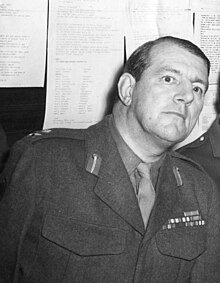Geoffrey Bourne, Baron Bourne

Geoffrey Kemp Bourne, Baron Bourne CMG KBE GCB ( October 5, 1902 , † June 26, 1982 ) was a British general who became a life peer in the House of Lords in 1964 under the Life Peerages Act 1958 .
Life
Military training and World War II
After attending school in 1923, Bourne entered the Royal Artillery and trained as an officer there . After it was used between 1930 and 1932 in Hong Kong and from 1933 to 1934 in Gibraltar , it was a graduate of the Staff College in Camberley from 1935 to 1936 and the staff school of Colchester in 1937 . He was then an officer in the General Staff of the War Office between 1938 and 1939 and then at the beginning of the Second World War from 1940 to 1942 an officer in the planning staff .
In 1942 Bourne was a Brigadier General on the General Staff Mission in Washington, DC and shortly thereafter was Commanding Officer of the 21st Anti-Tank Regiment before being an officer in the General Staff of the SEAC ( South East Asia Command ) between 1943 and 1944 . In 1944 he took part in combat missions in Italy as Commanding Officer of the 152nd Field Regiment of the Ayrshire Earl of Carrick's Own Yeomanry and then in 1945 was a member of the General Staff of the 1st Airborne Corps in northwestern Europe .
Post-war period and member of the House of Lords
After the end of the Second World War, Bourne was initially between 1945 and 1947 commander of the Royal Artillery of the 5th Indian 5th Infantry Division in Java and there, last in 1946, also acting general officer commanding of this division. After he was head of the British Mission in Burma from 1947 to 1948 , he succeeded Otway Herbert from January 16, 1949 until he was replaced by Charles Coleman on October 24, 1951 as Commander of the British Sector of Berlin .
Then Bourne was to succeed Gerald Lathbury between 1951 and his replacement by Francis Rome in 1952 commander of the 16th Airborne Division ( 16th Airborne Division ), before it then 1953 George Erskine as commander in chief ( General Officer Commanding in Chief ) of Ostkommandos ( Eastern Command was) . In this post he was followed by Francis Festing in 1954 , while he himself was the successor to Hugh Stockwell between 1954 and his replacement by Roger Bower in 1956, General Officer Commanding of the troops and director of operations in the Malaya Federation ( Malaya Command ). He also held the position of Colonel Commandant of the Royal Regiment of Artillery between 1954 and 1967 .
1957 Bourne was as successor to Charles Keightley commander in chief of the troops in the Middle East ( Middle East Command ) and held this post until he was replaced again in 1958 by Roger Bower. Most recently, he was the successor to Guy Russell from 1958 until his replacement by Robert Heatlie Scott in 1960, in command of the Imperial Defense College . During this time he also acted as aide-de-camp for Queen Elizabeth II between 1959 and 1960 .
Bourne, who retired in 1960, was Honorary Colonel of the 10th Battalion Parachute Regiment between 1960 and 1965 and became Companion of the Order of St. Michael and St. George , Knight Commander of the Order of the British Empire and Knight Grand Cross des Order of the Bath .
By a Letters Patent from August 22, 1964 Bourne was as a life peer with the title Baron Bourne , of Atherstone in the County of Warwickshire, according to the Life Peerages Act 1958 into the nobility raised and was as such until his death in the House of Lords as a member.
Web links
- Geoffrey Bourne at Hansard (English)
- Entry in Leigh Rayment Peerage
- General Geoffrey Kemp Bourne, Baron Bourne, on thepeerage.com , accessed September 11, 2016.
- Entry in The Generals of Word War II
| personal data | |
|---|---|
| SURNAME | Bourne, Geoffrey, Baron Bourne |
| ALTERNATIVE NAMES | Bourne, Geoffrey Kemp, Baron Bourne (full name) |
| BRIEF DESCRIPTION | British general |
| DATE OF BIRTH | October 5, 1902 |
| DATE OF DEATH | June 26, 1982 |

